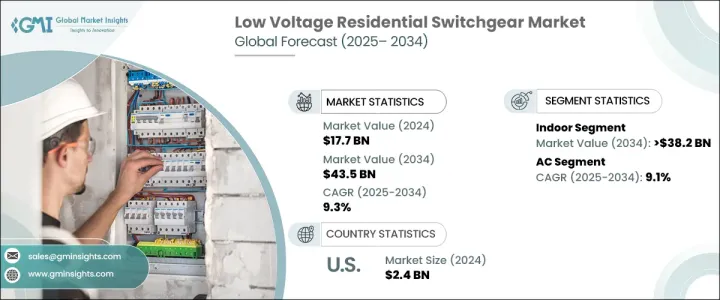PUBLISHER: Global Market Insights Inc. | PRODUCT CODE: 1716513

PUBLISHER: Global Market Insights Inc. | PRODUCT CODE: 1716513
Low Voltage Residential Switchgear Market Opportunity, Growth Drivers, Industry Trend Analysis, and Forecast 2025 - 2034
The Global Low Voltage Residential Switchgear Market was valued at USD 17.7 billion in 2024 and is projected to grow at a CAGR of 9.3% between 2025 and 2034. The market is witnessing steady growth due to rapid urbanization, increasing electricity consumption, and the widespread integration of smart home technologies. As living standards improve worldwide, residential construction activity is on the rise, driving the demand for efficient, reliable, and safe electrical distribution systems. Developing economies, in particular, are experiencing significant urban expansion, leading to a growing need for low voltage switchgear in residential infrastructures. The growing consumer preference for smart homes equipped with IoT-enabled systems and energy-efficient solutions is further fueling the demand.

Smart switchgear, offering real-time monitoring, automated control, and enhanced safety, is becoming an essential component of modern residential electrical setups. Additionally, the increasing focus on sustainability and energy conservation has led to higher adoption of smart power management systems in households, contributing to the expanding market size. Government initiatives promoting the use of renewable energy and energy-saving practices are also playing a crucial role in driving market growth. As consumers seek safer and more efficient solutions, the demand for advanced low voltage residential switchgear continues to rise, ensuring long-term market expansion.
| Market Scope | |
|---|---|
| Start Year | 2024 |
| Forecast Year | 2025-2034 |
| Start Value | $17.7 Billion |
| Forecast Value | $43.5 Billion |
| CAGR | 9.3% |
The indoor segment is expected to generate USD 38.2 billion by 2034, driven by the increasing adoption of smart home technologies and energy-efficient electrical systems. The rising demand for IoT-enabled indoor switchgear is being fueled by growing consumer awareness about energy management and the need for enhanced safety and automation in residential spaces. Government regulations supporting energy conservation and promoting the use of renewable energy sources in power generation are further accelerating the growth of this segment. Advanced features such as compact designs, improved communication capabilities, and enhanced safety mechanisms make modern indoor switchgear a preferred choice for utility, commercial, and residential applications.
The low voltage residential switchgear market in the AC segment is projected to grow at a 9.1% CAGR through 2034. The continued dominance of alternating current (AC) power in electricity distribution and transmission, owing to its efficiency in long-distance power transfer, is fueling this growth. In Europe, ongoing infrastructure assessments aimed at identifying and addressing gaps in electricity transmission are creating new opportunities for the market. The rising need for reliable and efficient electrical systems in residential settings is propelling the demand for advanced switchgear solutions that ensure seamless power distribution and minimize disruptions.
The U.S. low voltage residential switchgear market generated USD 2.4 billion in 2024. The increasing use of energy-intensive household appliances, including air conditioners and electric heating units, is driving the need for more sophisticated AC-based switchgear. With the rising prevalence of smart devices and automated systems in homes, there is a growing emphasis on circuit protection, overload management, and voltage control. As residential power consumption continues to increase, the market is shifting towards intelligent and adaptive switchgear systems that enhance operational efficiency and ensure the safety of household electrical systems.
Table of Contents
Chapter 1 Methodology & Scope
- 1.1 Market definitions
- 1.2 Base estimates & calculations
- 1.3 Forecast calculation
- 1.4 Data sources
- 1.4.1 Primary
- 1.4.2 Secondary
- 1.4.2.1 Paid
- 1.4.2.2 Public
Chapter 2 Executive Summary
- 2.1 Industry synopsis, 2021 - 2034
Chapter 3 Industry Insights
- 3.1 Industry ecosystem analysis
- 3.2 Regulatory landscape
- 3.3 Industry impact forces
- 3.3.1 Growth drivers
- 3.3.2 Industry pitfalls & challenges
- 3.4 Growth potential analysis
- 3.5 Porter's analysis
- 3.5.1 Bargaining power of suppliers
- 3.5.2 Bargaining power of buyers
- 3.5.3 Threat of new entrants
- 3.5.4 Threat of substitutes
- 3.6 PESTEL analysis
Chapter 4 Competitive landscape, 2024
- 4.1 Strategic dashboard
- 4.2 Innovation & sustainability landscape
Chapter 5 Market Size and Forecast, By Installation 2021 – 2034 (USD Million, ‘000 Units)
- 5.1 Key trends
- 5.2 Indoor
- 5.3 Outdoor
Chapter 6 Market Size and Forecast, By Current 2021 – 2034 (USD Million, ‘000 Units)
- 6.1 Key trends
- 6.2 AC
- 6.3 DC
Chapter 7 Market Size and Forecast, By Region, 2021 – 2034 (USD Million, ‘000 Units)
- 7.1 Key trends
- 7.2 North America
- 7.2.1 U.S.
- 7.2.2 Canada
- 7.2.3 Mexico
- 7.3 Europe
- 7.3.1 UK
- 7.3.2 Germany
- 7.3.3 France
- 7.3.4 Russia
- 7.3.5 Italy
- 7.3.6 Spain
- 7.4 Asia Pacific
- 7.4.1 China
- 7.4.2 Australia
- 7.4.3 India
- 7.4.4 Japan
- 7.4.5 South Korea
- 7.5 Middle East & Africa
- 7.5.1 Saudi Arabia
- 7.5.2 UAE
- 7.5.3 Turkey
- 7.5.4 South Africa
- 7.5.5 Egypt
- 7.6 Latin America
- 7.6.1 Brazil
- 7.6.2 Argentina
Chapter 8 Company Profiles
- 8.1 ABB
- 8.2 Bharat Heavy Electricals
- 8.3 CG Power and Industrial Solutions
- 8.4 CHINT Group
- 8.5 Eaton
- 8.6 Fuji Electric
- 8.7 General Electric
- 8.8 HD Hyundai Electric
- 8.9 Hitachi
- 8.10 Hyosung Heavy Industries
- 8.11 Lucy Group
- 8.12 Mitsubishi Electric
- 8.13 Ormazabal
- 8.14 Schneider Electric
- 8.15 Siemens
- 8.16 Skema
- 8.17 Toshiba




